Social Media Automation Strategy: 10 Tasks You Can Automate
This article will share ten social media marketing tasks you can automate to free up some headspace and clear up that to-do list.
You’re spinning multiple plates at once as a social media marketer. Brainstorming content ideas, scheduling posts, replying to comments, analyzing your social media marketing performance, tweaking your marketing strategy based on data — and repeating it all over again day in and day out for multiple social media platforms. Whew. It takes some elbow grease to keep the wheels spinning.
But what if you don’t have to do all that every single day? What if you could automate the mundane, repetitive tasks and focus on your core jobs that actually move the needle toward your return-on-investment (ROI)?
This article will share ten social media marketing tasks you can automate to free up some headspace and clear up that to-do list.
What is social media marketing automation (and why should you care)?
If you hear “automation” and think it’s one of those corporate jargon buzzwords that wears a suit and tie to work, you’re not alone. Put simply, social media automation is outsourcing the repetitive, manual, and sometimes boring tasks in your to-do list to software.
Adding software into the mix doesn’t just reduce your overhead; it also helps you maintain your social media presence without burning out.
Yes, automation also makes you more efficient and reduces the scope of human error (like forgetting to press “Publish”). But the crux of why automation is so great is because it allows you to spend time on the fun stuff (like creating content and speaking to your target audience) since a software is already taking care of the tedious tasks (like posting content and tracking performance). And isn’t that the dream? Automation puts the wind in the sails of your social media efforts.
Let’s dig into the meaty stuff now and talk about the actual tasks on your never-ending to-do list you can outsource to a software.
1: Use digital bookmarks to save content ideas
Have you ever lost that great article or watched an amazing video on which you could create A+ content? I’m still pining for a few. You can easily avoid this by installing content curation software’s Chrome extensions. They help you save links and organize URLs in folders — like a swipe file for your social media ideas.
The best thing about these automation tools is you can create a repository of content ideas without the heavy lifting. It’s literally done in a click. If you curate content or need to save any web links, don’t think twice about automating this task.
What about those social media post ideas you get in the shower? Or while walking the dog? I save them in Buffer Ideas. It’s like the Notes app, but exclusively for social media post ideas. You can jot down any notes, attach images, and organize your messy notes with groups & tags.
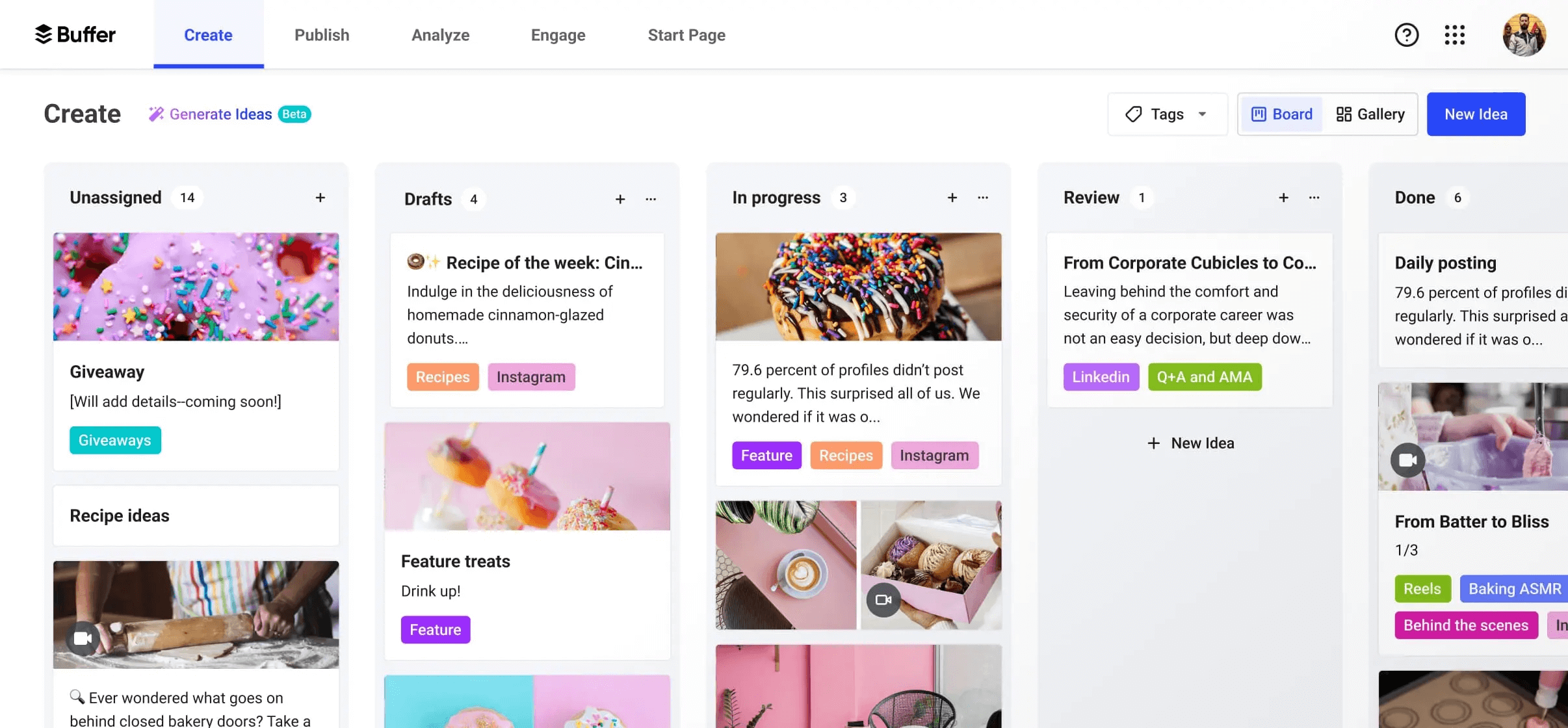
Social media automation tools I’d recommend for this task: Pocket, Buffer.
2: Use social media listening tools to stay on top of niche trends
Social listening observing what your audience is saying online and creating content around it. For instance, if you’re a haircare creator, you might notice trends around using rosemary water for hair growth and create a TikTok video on the topic.
But how do you know what’s hot and trending in your industry? Yes, there are several newsletters you could subscribe to. And sure, if you’re spending time online everyday and working in a specific niche, you’d know what’s up — to a certain extent. It’s still easy to miss a beat or two. Social listening tools help you automate the vague task of “monitor niche trends in my industry.”
These automation tools help you uncover what your audience demographics are searching for, what their pain points are, and which solutions they are most excited about. Many software also contain trending topics with in-depth data on which terms & topics are trending — like Google Trends for social media.
⚡ Pro-tip: Many social networks also help you do this for their specific channel like Pinterest’s trend forecast and Instagram’s “Reel Trends” feature.
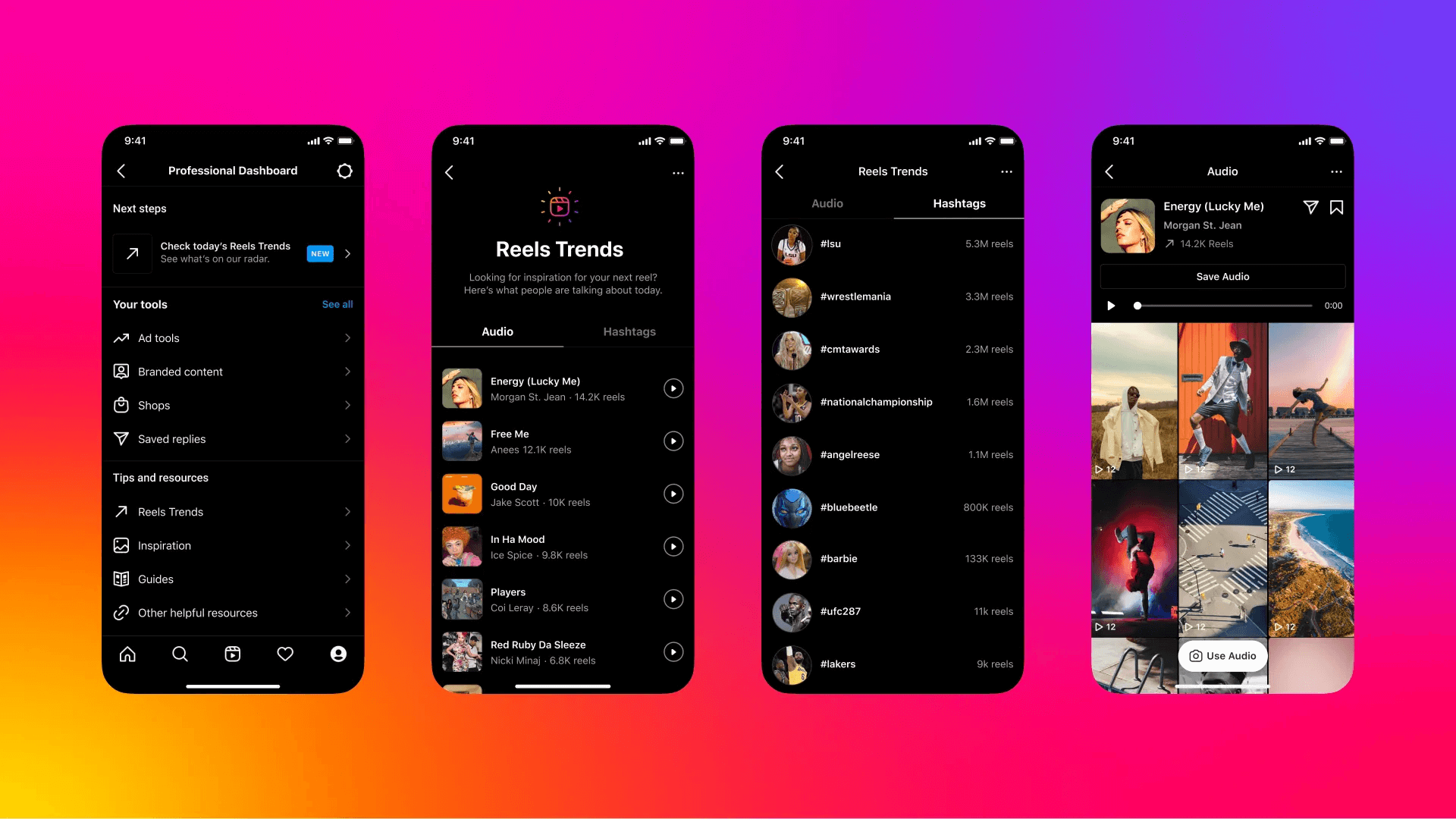
Keep an eye out for native social media trends to succeed for that particular platform. Match it with your learnings from social listening tools.
Social media automation tools I’d recommend for this task: Talkwalker, SparkToro.
3: Use social media scheduling tools to publish your posts
This is the easiest and most common social media task to automate. Many social platforms, like Instagram, provide you the option to schedule content in advance. But I wouldn’t recommend automating natively within social channels. Why?
1. You don’t see a visual content calendar natively on any social media platform. They don’t provide those functionalities yet. This means you can’t easily drag-drop and switch posts based on trends, company updates, and other external factors.
2. Scheduling across multiple platforms can get time-consuming. You can use a social media scheduler to schedule posts across multiple social accounts in one window. This means you can see everything in one tab and don’t have to use different social networks to schedule content (if you’re cross-posting) multiple times.
The problem? The market’s saturated forehead-deep with social media publishing tools. Use the one that gets you the most bang for your buck. I recommend Buffer because:
- It’s easy to use and the user experience isn’t overwhelming
- It lets you create custom posts for each network (if you wish to)
- It’s a leader in releasing integrations with new social media platforms
- It has a free tier and even it’s paid plans are quite affordable for small businesses
- It’s a full-fledged social media management tool so you can do multiple tasks with just one software

Whichever tool (or native feature) you choose, this task is the easiest to automate. And it’s beginner-friendly because it doesn’t require you to relinquish a lot of control. So, if you’re just beginning with your social media automation strategy, begin by automating publishing your posts in advance.
Social media automation tools I’d recommend for this task: Buffer.
Read more: How to Respond to Your Customers on Social Media Quickly
4: Use social media analysis software to analyze your performance
A big part of your job is reading the numbers. How many likes did your recent post receive? What’s the engagement rate? Which content format is performing the best? The questions keep on coming.
Social media analytics tools automate collecting all the metrics related to your performance data so you don’t have to do the math yourself. You still have to analyze the data for your social media goals, but you can easily outsource the “gather how my posts are doing” job.
In Buffer, you can set a timeframe and not only see the basic metrics like impressions, likes, yada yada, but also get answers to questions that actually matter — like, “Which is the best type of post for this social media channel?” or “At what time should I post to get the most social media engagement?” and even “How often should I post?”
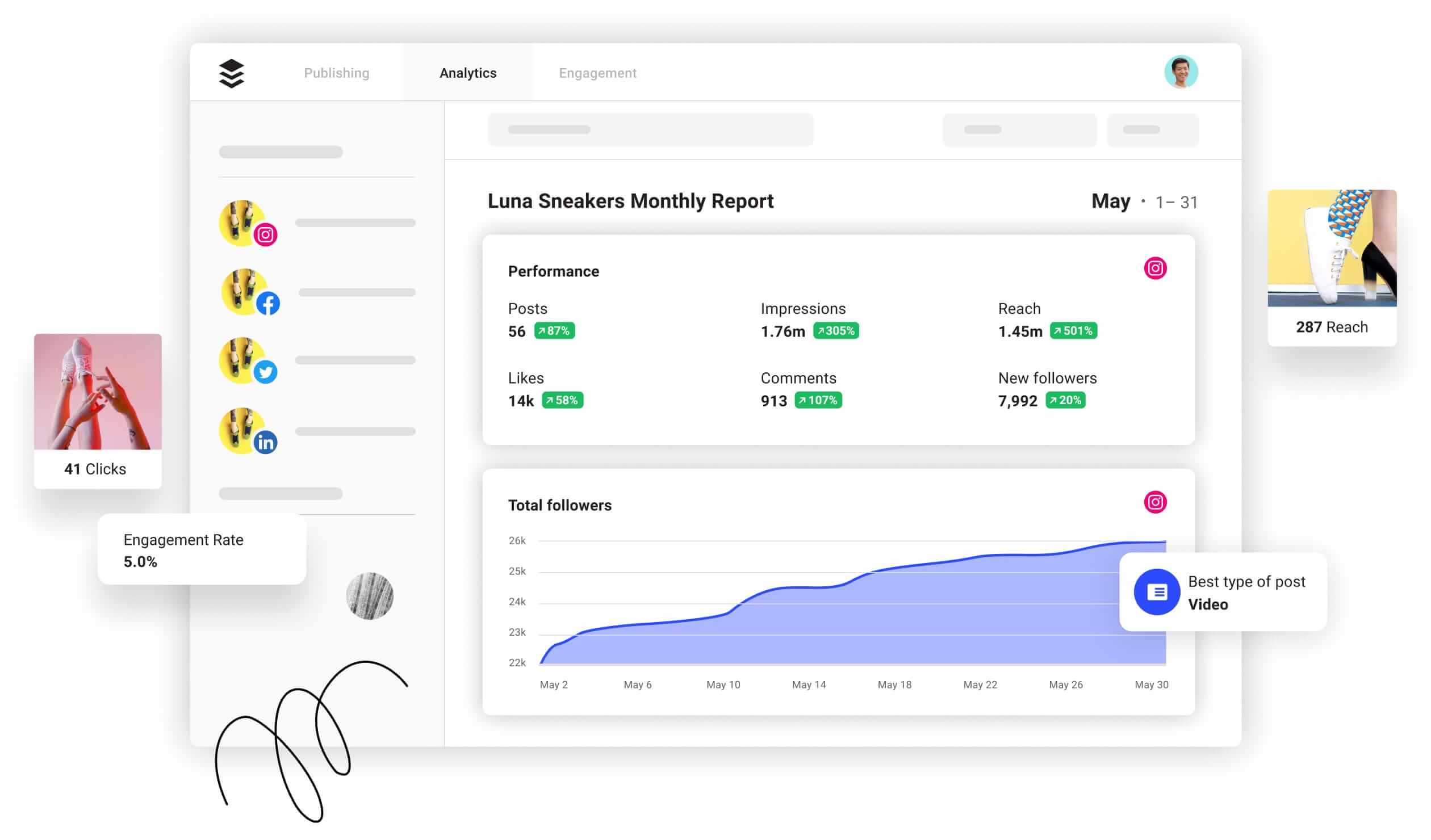
All of these answers are tailored to you and your social media accounts. The more you use Buffer, the more data you’ll have to make calculated insights into what’s working the best in your social media strategy.
Gathering insights from the analysis to optimize the social strategy is your wheelhouse. But gathering those metrics like a layman? Delegate that to a software.
Social media automation tools I’d recommend for this task: Buffer.
5: Use AI to refine your social media captions
AI is a big part of work today everywhere and the digital marketing world is no exception. You can use AI assistants to:
- Populate popular hashtags in a category
- Write the first draft of your social media caption
- Refine your existing copy to be more clear and concise
- Generate post ideas by giving a simple prompt of your niche
- Repurpose posts for one social media channel for another platform
The likes of ChatGPT are good for this, but many social media management tools (like Buffer) are also AI-powered. They come with an in-built assistant so you can do all of the above tasks without switching a single tab.

Many AI tools have excellent capabilities, but remember you can’t automate the task completely to them. Add your human voice and niche expertise into the mix. Read more about how we use AI at Buffer to strike the balance between automation and human.
Social media automation tools I’d recommend for this task: ChatGPT, Buffer.
6: Use chatbots to provide quick social media customer service
If you’ve used social media for customer service for even one day, you know the need for a chatbot that can quickly reply to customers, redirect them to the right help article, and sell products.
Instagram has a native feature to help you set up frequently asked questions (FAQs) in your chat box. When someone starts a chat with you, they will first see the commonly asked questions and can tap for an automated reply (which seems real-time).

But it’s not flexible or customizable and definitely not feasible to use your social networks for customer support. For this, you can use chatbots that help you automate responses in the conversation funnel and manage your social inbox. You can also use these chatbots creatively — like the posts you see asking you to comment “Link” to get a URL directly in your inbox.
Many of these chatbots also help you sell more as a small business. You can send messages for abandoned carts, for example. Or answer product-related queries real-time. They also work with all kinds of posts from Instagram Stories to direct messages (DMs).
Social media automation tools I’d recommend for this task: Manychat, Chatfuel.
Read more: The Beginner's Guide to Creating a Social Media Marketing Plan From Scratch
7: Use templates to create content and answer FAQs
Templates have a wide variety of use cases. You can set up FAQs for customer service, as we discussed above, but you can also use them in the content creation process.
For example, in any graphic design platform (like Canva), you can use templates to build off the visuals for a social media post. Perhaps you can templatize a certain type of content format (say, customer testimonial posts). Or on Instagram, you can use Reel templates to quickly edit your video.

Think: What are some steps in your social media marketing process that are repeatable and can be streamlined? You’ll find plenty of areas that can benefit from a template. Create these templates within a tool or on your own and use them to increase your efficiency.
Don’t be afraid to think outside the box here.
Social media automation tools I’d recommend for this task: Canva
8: Use social media collaboration tools to collaborate with your team
If you work in a team, you often need inputs from other team members on a social media post or you might need to approve what content is going live. Instead of Slacking each other back and forth, social media collaboration software can help you streamline the process.
One person can upload the post and wait for their manager’s approval. Other team members can chime in with inline comments and notes, too. Most social media collaboration tools also offer varying levels of access so everyone has the right controls.
Most social media management tools, like Buffer, come with this collaborative feature — allowing you to add multiple people, visualize your workflow, and set up user permissions.
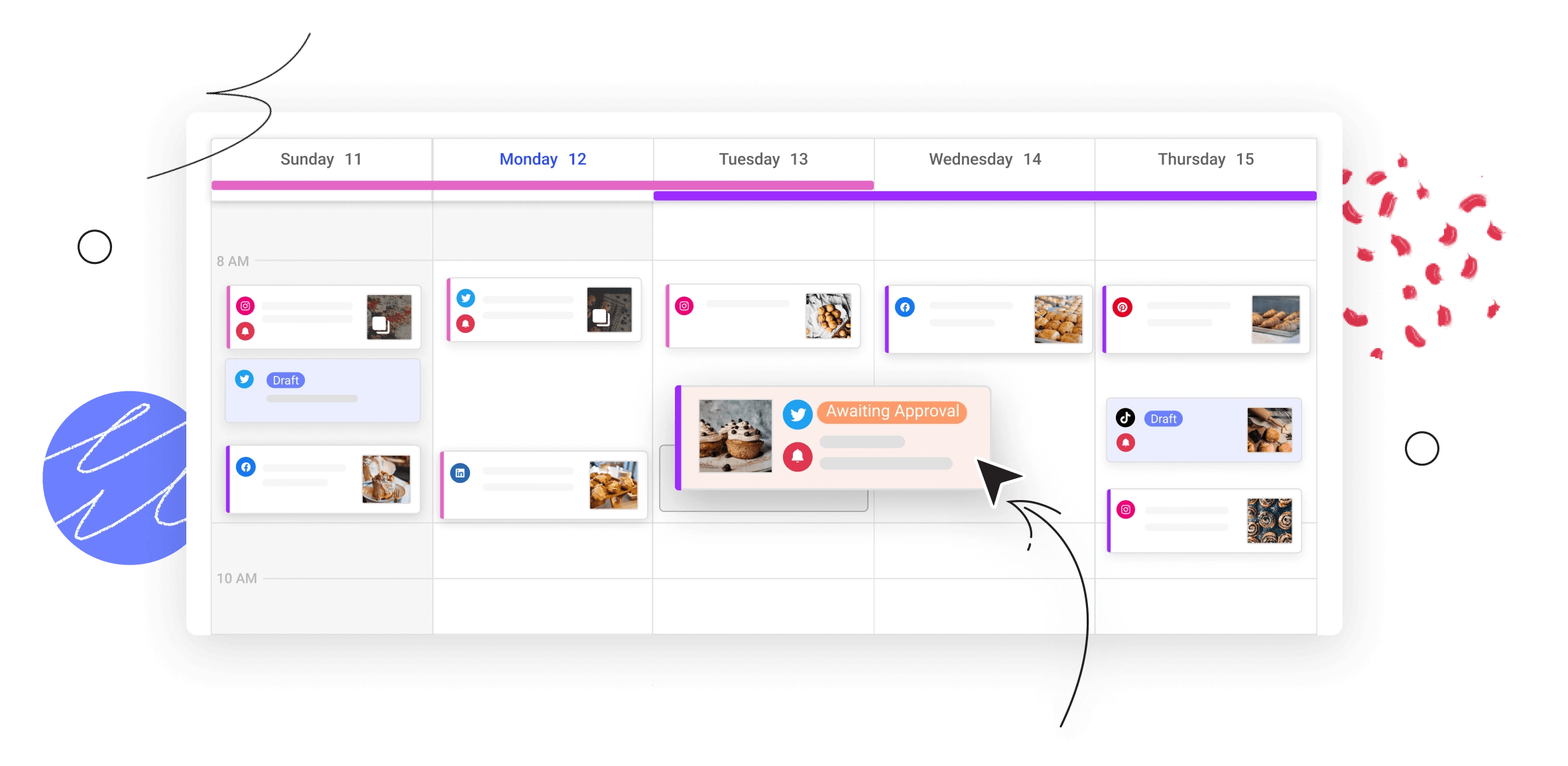
Collaborating with a team can add up a lot of hours if done manually. It’s best to automate the task so no message is missed and every step of your workflow is followed.
Social media automation tools I’d recommend for this task: Buffer.
9: Use social media monitoring software to track brand mentions
Social media monitoring involves tracking when someone mentions your brand in their post, Story, or comment. What for? For catching feedback, registering customer complaints, and spotting user-generated content.
But you’d get a notification for every brand mention, so why bother with automating this task? Here’s why:
1. You can miss notifications, especially if you get an influx of them
2. You can’t track brand mentions unless you were tagged
Besides, you can use social media monitoring tools to track much more than just brand mentions — like your product name(s) or a competitor’s negative reviews.
Many social media management software like Buffer allow you to respond to comments from inside the tool so you don’t have to toggle tabs continuously.
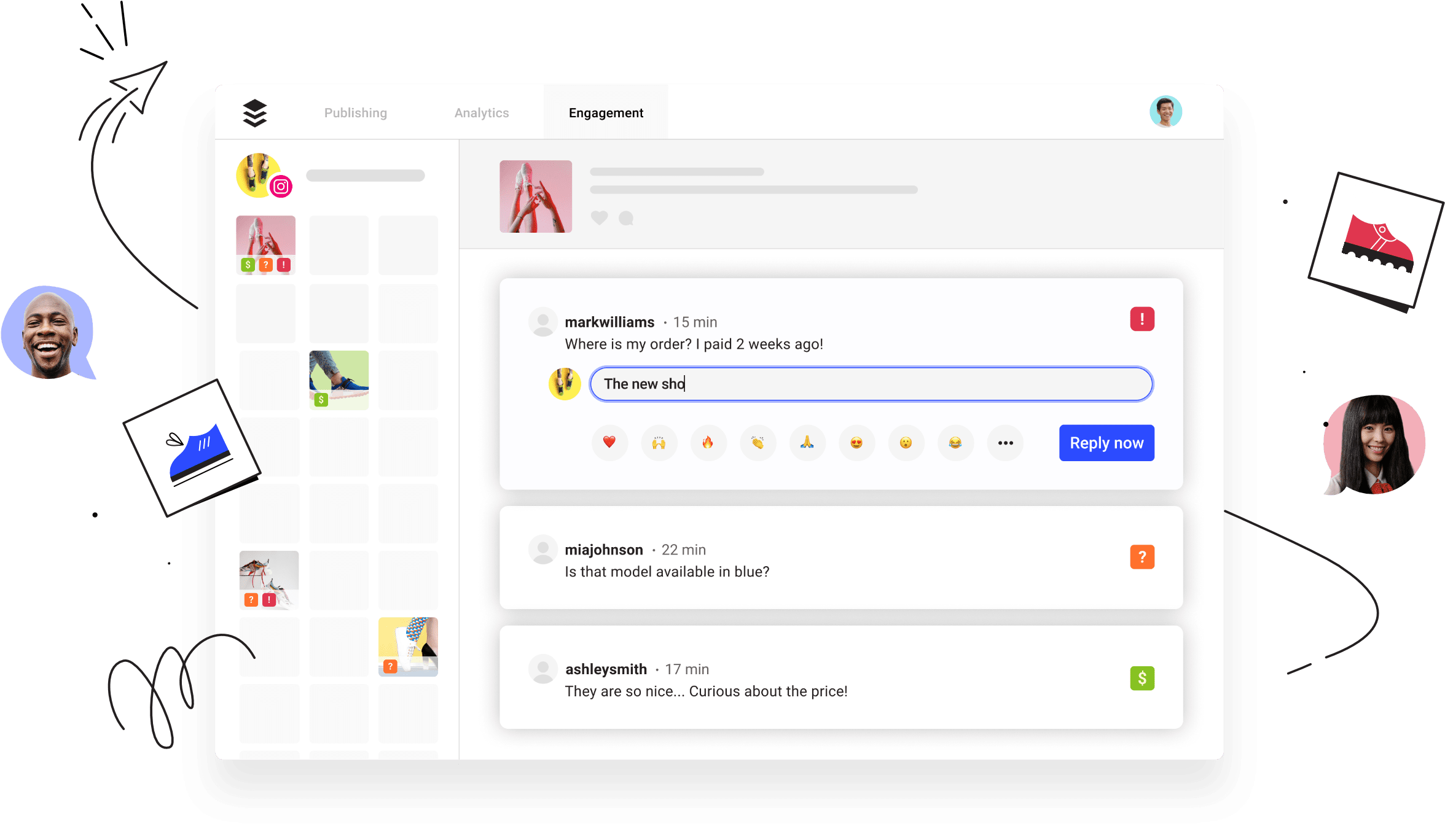
This is A+ for never leaving an audience comment unanswered, regardless of whether or not they mention you. There are also some dedicated social media monitoring tools that help you combine social listening and monitoring in one software — you can track brand & product mentions alongside trends and news topics.
Social media automation tools I’d recommend for this task: Buffer, Mention.
10: Use influencer discovery software to find creators
If your social media campaigns involve running an influencer marketing campaign, you can use influencer discovery tools to find influencers who match your criteria quickly.
Most of these tools rely on filters to help you narrow down the kind of influencer you want. You can add filters related to different platforms — like follower count, Reel views, engagement rate, etc.
This alone saves you a lot of time you would’ve spent scouting through different platforms hunting relevant influencers. Not only do these tools help you with campaign management, some influencer marketing tools also allow you to run ad campaigns from social posts of influencers.
Social media automation tools I’d recommend for this task: Modash, SARAL.
The best social media automation tools you can use
In summary, here are the tools mentioned you can use for social media automation:
- Buffer for scheduling your social media posts, analyzing their performance, collaborating with teammates, AI assistance, social media monitoring, and jotting down ideas.
- Pocket to save content ideas from the web.
- Talkwalker or SparkToro for social listening.
- ChatGPT for AI assistance with captions, copy, or generating post ideas.
- Manychat or Chatfuel for social media customer service.
- Canva for visual templates.
- Mention for social media monitoring.
The above list can seem like a lot of tools to use simultaneously.
I’d recommend using a dedicated social media management tool like Buffer to automate most of your tedious tasks and slowly add more to your tech stack as and when needed.
Try to find tools that can help you automate multiple jobs so you don’t have the financial and the psychological burden of using too much software.
Don’t automate the human interaction
Social media marketing automation is wonderful to keep your online presence intact, but remember to define how much you’ll automate.
For example, it’s great to use automation to answer a customer’s FAQs. But when queries need a personalized response, don’t use templates. Your audience can easily spot the automated response and they’ll feel like a cog in your social media machine (instead of a valued community member).
Avoid automating whatever activities give you the human touch on social media. This might mean responding to comments, showing up on videos, and replying to DMs thoughtfully. In the end, remember that automation should help you serve your audience better instead of diminishing their experience.
Further reading: How to Automate Your Content Repurposing in 5 Steps (From Someone Who Has Done It!)
Try Buffer for free
180,000+ creators, small businesses, and marketers use Buffer to grow their audiences every month.
Related Articles

TikTok just introduced Bulletin Boards, similar to Instagram's Broadcast Channels. Here's what you need to know.

We've reopened submissions for the new, cohort-based version of the Buffer Guest Post Program. Learn more in this article.

In this article, you'll find 20+ essential LinkedIn statistics that reveal the platform's reach, effectiveness, and continued growth.
